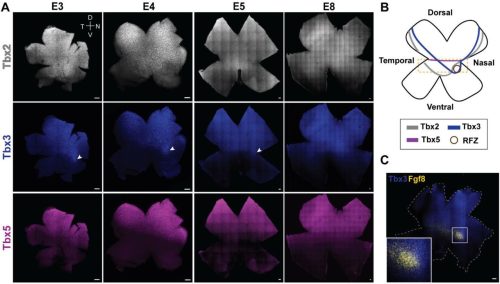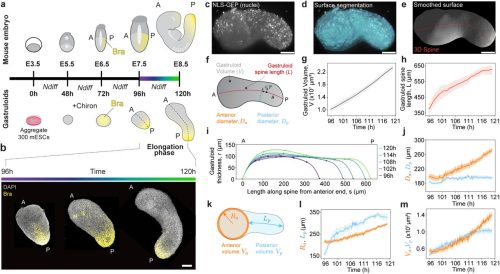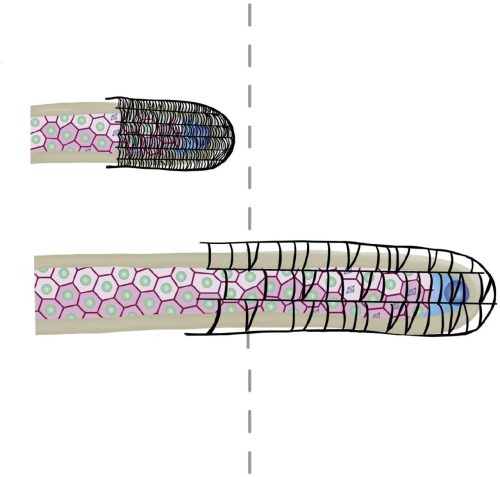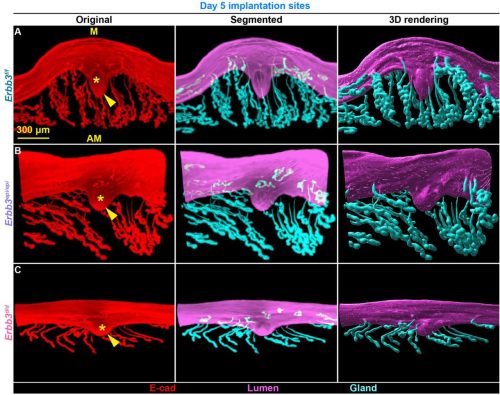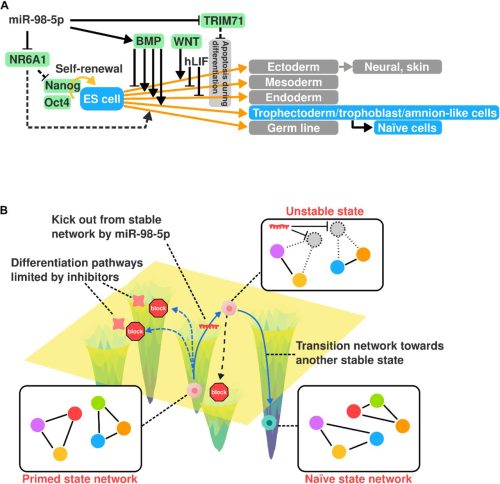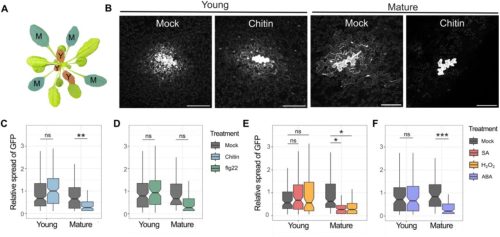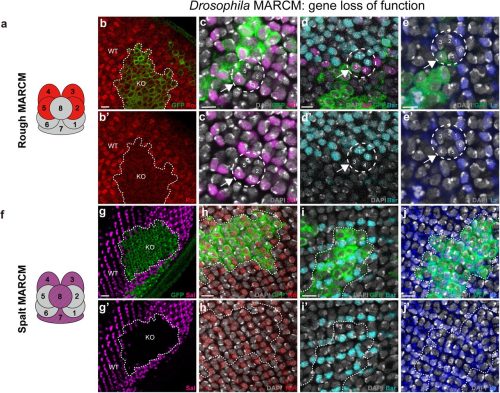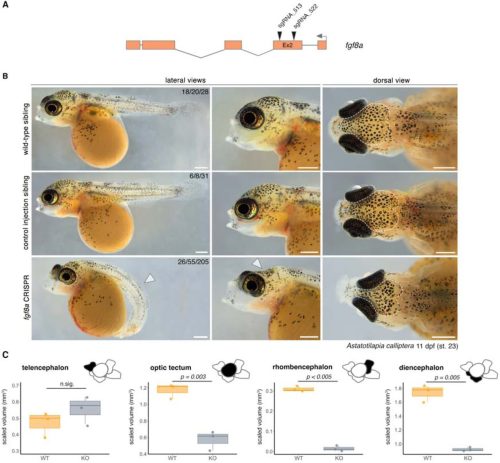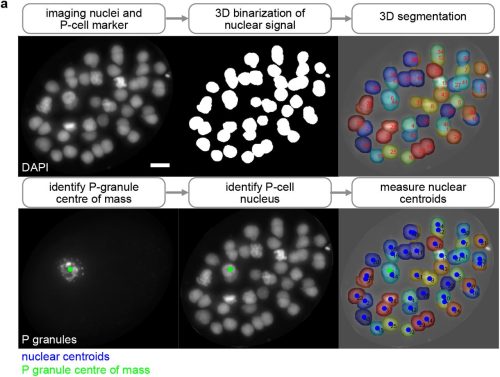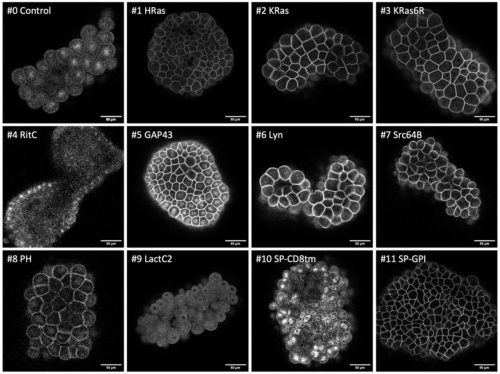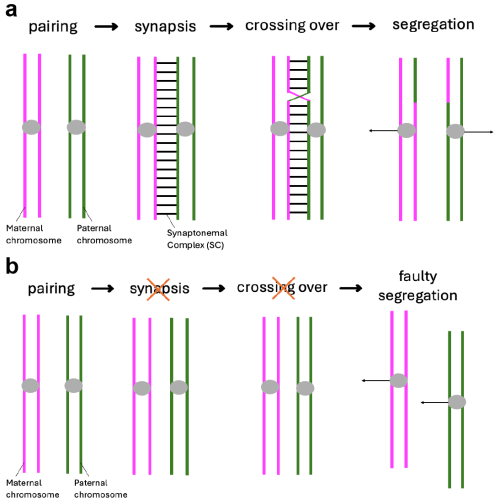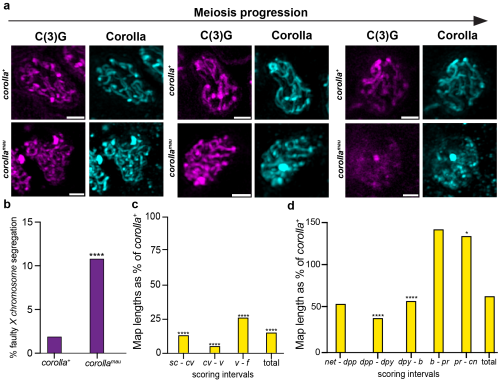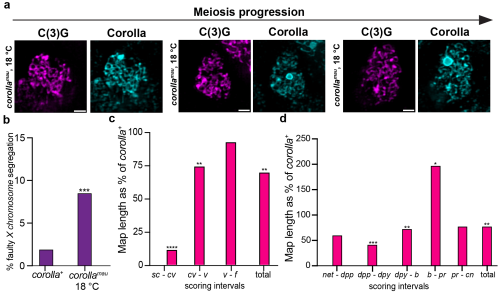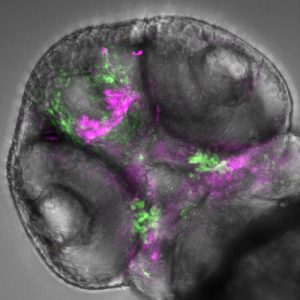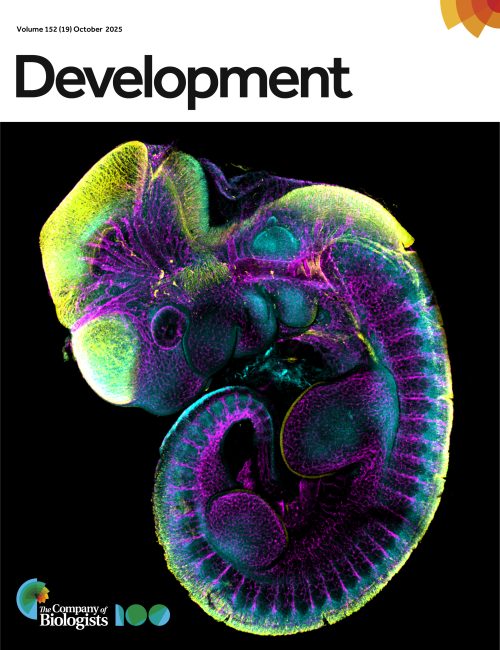November in preprints
Posted by the Node, on 2 December 2025
Welcome to our monthly trawl for developmental and stem cell biology (and related) preprints.
The preprints this month are hosted on bioRxiv – use these links below to get to the section you want:
- Patterning & signalling
- Morphogenesis & mechanics
- Genes & genomes
- Stem cells, regeneration & disease modelling
- Plant development
- Environment, evolution and development
Research practice and education
Spotted a preprint in this list that you love? If you’re keen to gain some science writing experience and be part of a friendly, diverse and international community, consider joining preLights and writing a preprint highlight article.
Developmental biology
| Patterning & signalling
The Actin regulator Mena promotes Wnt signalosome endocytosis and Wnt signalling
Sheng-yuan Wu, Marcela M. Moreno, Anna Noble, Amirul Haziq Azwan, Matthew Guille, Karen J. Liu, Matthias Krause

Notch and Wnt signalling interact for proper prosensory and non-sensory domain formation
Neelanjana Ray, Sai Manoz Lingamallu, Arjun Guha, Raj K. Ladher
In situ mutational screening and CRISPR interference reveal that the apterous Early enhancer is required for developmental boundary positioning
Gustavo Aguilar, Michèle Sickmann, Dimitri Bieli, Gordian Born, Markus Affolter, Martin Müller
Mutual Inhibition Model of pattern formation: The role of Wnt-Dickkopf interactions in driving Hydra body axis formation
Moritz Mercker, Alexey Kazarnikov, Anja Tursch, Thomas Richter, Suat Özbek, Thomas Holstein, Anna Marciniak-Czochra
Developmental and transcriptional programs that define the initiation of the forelimb
Vighnesh Ghatpande, Alecxander J Lewis, Kathryn E Windsor, Hyunji Lee, Aaron J Alcala, Douglas B. Menke, Can Cenik, Steven A Vokes
Loss of SPECC1L in cranial neural crest cells results in increased hedgehog signaling and frontonasal dysplasia
An J Tran, Brittany M Hufft-Martinez, Dana N Thalman, Lorena Maili, Sean McKinney, Jeremy P Goering, Paul A Trainor, Irfan Saadi
Transcriptional feedback of Erk signaling waves in zebrafish scale regeneration
Coline Coudeville, Tristan Guyomar, Julie Allamand, Franka Voigt, Alessandro De Simone
The cloacal outgrowth orchestrates co-development of the bladder and umbilical arteries
Xing Ye, Liguang Xia, Xianfa Yang, Ruirong Tan, Haochuan Zhang, Liming Lei, Jungang Huang, Yingsheng Zhang, Edward Morrisey, Ping Zhu, Zhongrong Li, Naihe Jing, Xue Li
Activity and retinoic acid drive hair cell spatial patterning in the zebrafish utricle
Selina Baeza-Loya, Jo Trang Bùi, David W Raible
Multiple glycoforms of TrkA interact with N-cadherin during trigeminal ganglion neurodevelopment
Caroline A. Halmi, Lisa A. Taneyhill
The BMP ligand Gdf6a Regulates Development of the Zebrafish Craniofacial Skeleton in a Pharyngeal Arch-Specific Manner
Sabrina C. Fox, Sarah M. Hay, Andrew J. Waskiewicz, Jennifer C. Hocking
Multimodal cell lineage reconstruction in the hindbrain reveals a link between progenitor origin and activity patterning
Matthias Blanc, Lydvina Meister, William C. Lemon, Ulla-maj Fiuza, Philipp J. Keller, Isabel Espinosa-Medina, Cristina Pujades
Extrinsic polarity cues control lamination versus cluster-based organisation in vertebrate retinal development
Christina Schlagheck, Xenia Podlipensky, Cassian Afting, Ronald Curticean, Irene Wacker, Rasmus R. Schröder, Venera Weinhardt, Lucie Zilova, Joachim Wittbrodt
Reconstituting epiblast–extraembryonic endoderm interactions restores anterior–ventral patterning in mouse stem cell–based embryo models
Natalia P. Smirnova, Sergey V. Ponomartsev, Tharvesh M. Liyakat Ali, Max Lycke, Brian K. Chung, Jonas Øgaard, Espen Melum, Jesse V Veenvliet, Stefan Krauss
WNT inhibition primes the transcriptional landscape of mesoderm to initiate a phased ventricular cardiomyocyte specification programme
V Velecela, A Bassil, E Fawcett, E Smith, D Konstantopoulos, F Salmén, AS Bernardo, S Hoppler
Cell division during Xenopus gastrulation influences neuroectoderm patterning
Ian Velloso, Rodrigo Araujo, Marko Horb, Jose G. Abreu
Cell Numbers Contribute to Cell Fate During Ciona Cardiopharyngeal Mesoderm Specification
Emily Singer, Haram Kim, Michael Levine, Nicholas Treen
TGFβ-dependent upregulation of OCIAD2 is essential for epithelial-to-mesenchymal transition during mesendoderm differentiation
Kajal Kamat, Maneesha S. Inamdar
Hox–Meis-relayed topographical genetic switch underlies cardiopharyngeal neural crest diversification, revealed by multimodal analysis
Akiyasu Iwase, Yasunobu Uchijima, Daiki Seya, Mayuko Kida, Hiroki Higashiyama, Kazuhiro Matsui, Akashi Taguchi, Yukihiro Harada, Yunce Wang, Shogo Yamamoto, Shiro Fukuda, Seitaro Nomura, Takahide Kohro, Chisa Shukunami, Haruhiko Akiyama, Masahide Seki, Akinori Kanai, Yutaka Suzuki, Teruhisa Kawamura, Osamu Nakagawa, Hiroto Katoh, Shumpei Ishikawa, Youichiro Wada, Hiroyuki Aburatani, Yukiko Kurihara, Sachiko Miyagawa-Tomita, Hiroki Kurihara
Sonic hedgehog signaling promotes basal epidermal fibrillin 3 expression for zebrafish fin ray branching
Samuel G. Horst, Gabriel A. Yette, Astra L. Henner, Scott Stewart, Kryn Stankunas
A nutrient-sensitive enterokine coordinates developmental plasticity through inter-organ signalling
L Bai, CI Ramos, F Leulier
Blood originates in hypoblasts during embryonic development
Yiming Chao, Hongji Li, Lu Liu, Zhengyi Tay, Shihui Zhang, Xiaolin Xu, Shao Xu, Yang Xiang, Degong Ruan, Yuanhua Huang, Guocheng Lan, Pengtao Liu, Ryohichi Sugimura
aPKC and F-actin Dynamics Promote Hippo Pathway Polarity in Asymmetrically Dividing Neuroblasts
Niranjan S. Joshi, Victoria M. Sullivan, Sherzod A. Tokamov, Richard G. Fehon
BMP–Smad1/9 signaling is required for PGC proliferation in zebrafish
Tao Zheng, Yaqi Li, Guangyuan Li, Zihang Wei, Jie Li, Zheng Jiang, Roshan Shah, Weiying Zhang, Cencan Xing, Anming Meng, Xiaotong Wu
Multimerin1, not Galectin-8, Promotes Gastric Chief Cell Differentiation by Tempering WNT Signaling
Xiaobo Lin, Gabriel Nicolazzi, Xuemei Liu, Chinye Nwokolo, Yeheil Zick, José B. Sáenz, Jeffrey W. Brown
| Morphogenesis & mechanics
Tug-of-war between cortical and cytoplasmic forces shaping planar of 4-cell stage embryos
Silvia Caballero-Mancebo, Daniel Gonzalez Suarez, Janet Chenevert, Sameh Ben-Aicha, Lydia Besnardeau, Alex McDougall, Rémi Dumollard
A Natural Programmable Metamaterial Controls 3D Curvature of Compound Eyes
Juan Garrido-García, Rhian F. Walther, Jesús Torres-Tirado, Jesús A. Andrés-San Román, José A. Sanz-Herrera, Franck Pichaud, Fernando Casares, Luis M. Escudero
Morphogenesis of the Carapace from Phyllosoma to Puerulus in Spiny Lobsters
Haruhiko Adachi, Kentaro Morikawa, Yasuhiro Inoue, Shigeru Kondo
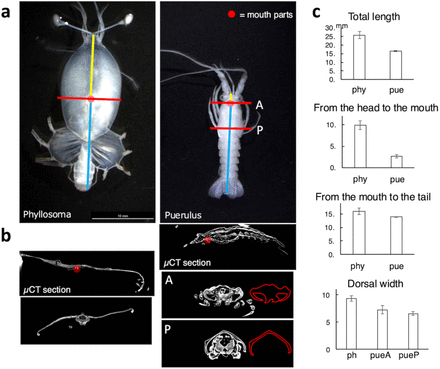
Cdh-2 modulates cortical F-actin distribution to establish stiffness gradients driving forebrain roof plate invagination
Meenu Sachdeva, Prasenjit Sharma, Pankaj Gupta, Mohd Ali Abbas Zaidi, Sweta Kushwaha, Jonaki Sen
An AmotL2–Yap1 Module Integrates Flow and Junctional Mechanics to Specify Vascular Pruning Hotspots
Maria P. Kotini, Ludovico Maggi, Etienne Schmelzer, Hiroyuki Nakajima, Heinz-Georg Belting, Markus Affolter
Supracellular Mechanics and Counter-Rotational Bilateral Flows Orchestrate Posterior Morphogenesis
Geneva Masak, Lance A Davidson
Imp1 acts as a dosage- and stage-dependent temporal rheostat orchestrating radial glial fate transitions and cortical morphogenesis
Romie Angelo G. Azur, Daniel Feliciano, Isabel Espinosa-Medina, Raghabendra Adhikari, Joaquin Lilao-Garzón, Ella Jensen, Ching-Po Yang, Tzumin Lee
MLT-11 is necessary for C. elegans embryogenesis and conserved sequences play distinct roles in cuticle structure
James Matthew Ragle, Ariela Turzo, Anton Jackson, An A. Vo, Vivian T. Pham, Keya Daly, John C. Clancy, Max T. Levenson, Alex D. Lee, Jordan D. Ward
Planar cell polarity-directed cell crawling drives polarized hair follicle morphogenesis
Rishabh Sharan, XinXin Du, Liliya Leybova, Anyoko Sewavi, Abhishek Biswas, Danelle Devenport
Stationary and germ layer-specific cellular flows shape the zebrafish gastrula
Susan Wopat, Pieter Derksen, Vishank Jain-Sharma, Gary Han, Nikolas Claussen, Sebastian Streichan
Absence of posterior commissure and sub-commissural organ precedes encephalocele development in a new mouse model
Hiu Nam Chan, Dawn Savery, Shreeta Chakraborty, Nina Wenzlitschke, Pedro P. Rocha, Andrew J. Copp
A Conserved Mechanism in Eye Optical Development: Lens Nucleus Centralization in Xenopus laevis
Karla A. Garcia, Kelly Ai-Sun Tseng, Irene Vorontsova
Junctional Heterogeneity Shapes Epithelial Morphospace
Anubhav Prakash, Raman Kaushik, Nishant Singh, Ankita Walvekar, Sradha Saji, Raj K Ladher
| Genes & genomes
Integrating bulk and single cell RNA-seq refines transcriptomic profiles of individual C. elegans neurons
Alec Barrett, Erdem Varol, Alexis Weinreb, Seth R. Taylor, Rebecca M. McWhirter, Cyril Cros, Berta Vidal, Manasa Basaravaju, Abigail Poff, John A. Tipps, Maryam Majeed, Chen Wang, Emily A. Bayer, Molly Reilly, Eviatar Yemini, HaoSheng Sun, Oliver Hobert, David M. Miller III, Marc Hammarlund
Mapping embryonic mouse lung development using enhanced spatial transcriptomics
Pengfei Zhang, Benjamin K. Law, Katharine Goodwin, Michelle M. Chan, Celeste M. Nelson
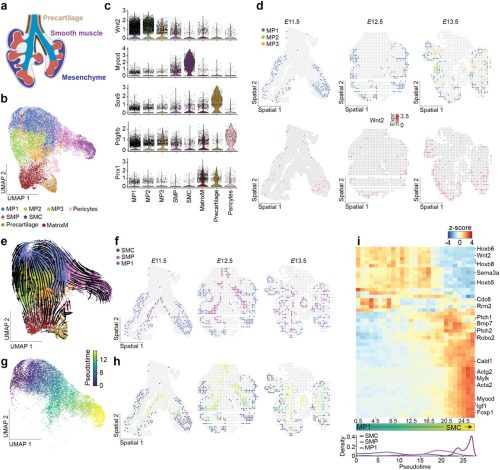
Chromatin priming and Hunchback recruitment integrate spatial and temporal cues in Drosophila neuroblasts
Ayanthi Bhattacharya, Hemalatha Rao, Sonia Q Sen
A 3D Amphioxus Brain Atlas Illuminates the Blueprint of the Ancestral Chordate Brain
Che-Yi Lin, Wen-Hsin Hsu, Mei-Yeh Jade Lu, Yi-Hua Chen, Yi-Chih Chen, Yi-Hsien Su, Shen-Ju Chou, Jr-Kai Yu
Integrative analysis of GTEx data reveals that systemic transcriptomes correlate with human spermatogenic dysfunction
Xing An, Feng-Yun Xie, Juan Chen, Yingyu Chen, Jun-Yu Ma
XIST Drives X-Chromosome Inactivation and Safeguards Female Extraembryonic Cells in Humans
Amitesh Panda, Léo Carrillo, Bradley Philip Balaton, Jeanne Brouillet, Solomon Nshemereirwe, Jarne Bonroy, Charbel Alfeghaly, Romina Facchinello, Sherif Khodeer, Nicolas Peredo, Ruben Boers, Gael Castel, Charlie London, Emmanuel Cazottes, Madeleine Moscatelli, Raissa Songwa Tchinda, Thi Xuan Ai Pham, San Kit To, Ryan Nicolaas Allsop, Yang Wang, Desislava Staneva, Peter J. Rugg-Gunn, Kathy K. Niakan, Joost Gribnau, Jean-François Ouimette, Claire Rougeulle, Vincent Pasque
Genotype-phenotype correlations in Wilms tumor initiation
N.S. Pop, D. Koot, C.M. Brouwers, M.M. Linssen, J.W.C. Claassens, C.W.J. Cartlidge, D.D. Özdemir, K.S. Dolt, P. Hohenstein
N6-Methyladenosine Safeguards Mouse and Human Germline Competence
Rujuan Zuo, Baoyan Bai, Kang-Xuan Jin, Mirra Louise Cicilie Søegaard, Erkut Ilaslan, Ying Yao, Jingwei Li, Łukasz Wyrożemski, Yanjiao Li, Xuechen Wu, Junbai Wang, Arne Klungland, Mads Lerdrup, Adam Filipczyk
Multi-dimensional regulation of LIN-28 temporal expression dynamics in the C. elegans heterochronic gene cascade
Charles Nelson, Victor Ambros
Cell type-independent timekeeping gene modules enable embryonic stage prediction in zebrafish
Rupa Kanchi, Sandra L Grimm, Divya Vella, Richard Saoud, Tanmay Gandhi, Amrit Koirala, Ailen Cervino, Jacalyn MacGowan, Cristian Coarfa, Margot Kossmann Williams
Newly Evolved Endogenous Retroviruses Prime the Ovarian Reserve for Activation
Yasuhisa Munakata, Mengwen Hu, Raissa G Dani, Naokazu Inoue, Richard M. Schultz, Satoshi H. Namekawa
The long-standing relationship between replication timing, gene expression, and chromatin accessibility is maintained in early mouse embryogenesis
Juan Carlos Rivera-Mulia
DNA methylation reprogramming in marsupial embryos is restricted to the extraembryonic lineage
Allegra Angeloni, Jillian M. Hammond, Timothy J. Peters, Andre L. M. Reis, Leah Kemp, Timothy Amos, Hasindu Gamaarachchi, Sam Humphries, Lynda A. Wilmott, Suranjana Pal, V. Pragathi Masamsetti, Megan Weatherstone, Kenny Chi Kin Ip, Karina Pazaky, Alice Steel, Ruth Lyons, Elly D. Walters, Ning Liu, Patrick Tam, Jose M. Polo, Paul Waters, Susan J. Clark, Linda J. Richards, Andrew D. Smith, Heather Lee, Ira W. Deveson, Oliver W. Griffith, Ksenia Skvortsova
Drosophila ryanodine receptor gene triggers functional and developmental muscle properties and could be used to assess the impact of human RYR1 mutations
Monika Zmojdzian, Teresa Jagla, Florian Cherik, Magda Dubinska-Magiera, Marta Migocka-Patrzalek, Malgorzata Daczewska, John Rendu, Krzysztof Jagla, Catherine Sarret
Pachytene piRNAs define a conserved program of meiotic gene regulation
Zuzana Loubalova, Franziska Ahrend, Daniel Stoyko, Rachel Cosby, Sherry Ralls, Gunter Meister, Todd Macfarlan, Astrid D. Haase
R-loops orchestrate the maternal-to-zygotic transition by harnessing RNA polymerase II pause release
Yaoyi Li, Qing Li, Xinxiu Wang, Chao Di, Yingliang Sheng, Qingqing Cai, Sainan Huang, Jiayu Chen, Guangming Wu, Shaorong Gao, Hongjie Yao
High-throughput functional characterization of enhancers in totipotent-like cells
Lingyue Yang, Tianran Peng, Yating Zhu, Xuzhao Zhai, Boyan Huang, Ling Li, Tao Zhang, Jiekai Chen, Dan Liang, Jiangping He, Man Zhang
Spatiotemporal control of PIWI compartmentalization by mitochondrial scaffolds defines pachytene piRNA pathway organization
Xiaoyuan Yan, Chao Wei, Jeffrey M. Mann, Guanyi Shang, Qianyi Wang, Huirong Xie, Elena Y. Demireva, Liangliang Sun, Deqiang Ding, Chen Chen
| Stem cells, regeneration & disease modelling
Derivation of primed sheep embryonic stem cells and conversion to an intermediate naïve-like state
TS Shyamkumar, Manuel A. Vasquez-Hidalgo, Viju V. Pillai
map3k1 is required for spatial restriction of progenitor differentiation in planarians
Bryanna Isela-Inez Canales, Hunter O. King, Peter W. Reddien
Hippo signaling differentially regulates distal progenitor subpopulations and their transitional states to construct the mammalian lungs
Kuan Zhang, Madhuri Basak, Youssef Zaher, Erica Yao, Shao-An Wang, Thin Aung, Pao-Tien Chuang
Novel markers for haemogenic endothelium and haematopoietic progenitors in the mouse yolk sac
Guillermo Diez-Pinel, Alessandro Muratore, Christiana Ruhrberg, Giovanni Canu
T-regulatory cell protection of progenitor cells from CD4+ T-cell-mediated cytotoxicity is essential for endogenous mouse digit-tip regeneration
Zachery Beal, Robyn E. Reeve, Elizabeth Hammond, Nadia Rosenthal, James Godwin
Unified Generation of Regionalized Neural Organoids from Single-Lumen Neuroepithelium
Jyoti Rao, Zhisong He, Sebastian Loskarn, Audrey Bender, Youngmin Jo, Johanna Lückel, Martina Curcio, Irineja Cubela, J. Gray Camp, Barbara Treutlein, Matthias P. Lutolf
A zebrafish seizure model of cblX syndrome reveals a dose-dependent refractory response to mTor inhibition
Claudia B. Gil, David Paz, Briana E. Pinales, Victoria L. Castro, Claire E. Perucho, Annalise Gonzales, Giulio Francia, Sepiso K. Masenga, Antentor Hinton Jr., Anita M. Quintana
Interferon signaling promotes early neutrophil recruitment after zebrafish heart injury
Alexis V. Schmid, James A. Gagnon

Paternal over- and under-nutrition program fetal and placental development in a sex-specific manner in mice
Hannah L. Morgan, Nader Eid, Nadine Holmes, Matthew Carlile, Sonal Henson, Fei Sang, Victoria Wright, Marcos Castellanos-Uribe, Iqbal Khan, Nazia Nazar, Sean T. May, Rod T. Mitchell, Federica Lopes, Robert S. Robinson, Augusto A. Coppi, Vipul Batra, Adam J. Watkins
Late-Onset Preeclampsia is characterised by Accelerated Placental Aging
Anya L Arthurs, Rudrarup Bhattacharjee, Melanie D Smith, Dulce Medina, Ellen Menkhorst, German Mora, Jessica M Williamson, Lynda K Harris, Jose M Polo, David A MacIntyre, Claire T Roberts
A Minimally Invasive, Scalable and Reproducible Neonatal Rat Model of Severe Focal Brain Injury
Victor Mondal, Emily Ross-Munro, Gayathri K. Balasuriya, Ritu Kumari, Isabelle K. Shearer, Andjela Micic, Abdullah Al Mamun Sohag, Alan Shi, Mikaela Barresi, David R. Nisbet, Glenn F. King, Richard J. Williams, Pierre Gressens, Flora Y Wong, Jeanie L.Y. Cheong, David W. Walker, Mary Tolcos, Bobbi Fleiss
Developmental control of DNA damage responses in α- and β-cells shapes the selective beta-cell susceptibility in diabetes
Sneha S. Varghese, Alessandro Giovanni Hernandez-De La Peña, Aparamita Pandey, Laura Anchondo, Xiwei Wu, Supriyo Bhattacharya, Sangeeta Dhawan
N6-methyladenosine regulation of mRNA translation is essential for early human erythropoiesis
Daniel A. Kuppers, Sonali Arora, Cindy L. Wladyka, Ruiqi Ge, Shun Liu, Yong Peng, Rui Su, Anne Wilhite, Jianjun Chen, Chuan He, Andrew C. Hsieh, Patrick J. Paddison
Spinal cord regeneration deploys cell-type specific developmental and non-developmental strategies to restore neuron diversity
Avery Angell Swearer, Samuel B. Perkowski, Iba Husain, Thiago A. Figueiredo, Morgan E. McCartney, Andrea E. Wills
Susceptibility of Human Neural Stem Cells to SARS-CoV-2: Entry Mechanisms and Glycocalyx Influence
Ann Song, Cori Zuvia, Prue Talbot
Extracellular matrix remodeling supports Hydra vulgaris head regeneration and stem cell invasion
Ben D. Cox, Jasmine Mah, Angel Perez, Celina E. Juliano
Human pluripotent stem cell-derived macrophages modify development of human kidney organoids
Filipa M. Lopes, Ioannis Bantounas, Alexandra Sarov, Adrian S. Woolf, Susan J. Kimber
Lateral plate mesoderm directs human amnion and ventral skin organoid formation
Anh Phuong Le, Jin Kim, Qianyi Ma, Kelly Y. Gim, Sara A. Serdy, Edward H. Lee, Shariqa T. Shaila, Taiki Nakajima, Carl Nist-Lund, Yosuke Mai, Ian A. Glass, Laura C. Nuzzi, Catherine T. McNamara, Brian I. Labow, Liang Sun, Jiyoon Lee, Olivier Pourquié, Karl R. Koehler
IGF-1 from bone marrow Adipoq-lineage cells stimulates endocortical bone formation in mature female mice
Joshua C Bertels, Jasmin Koehnken Sawall, Brian Dulmovits, Xiaobin Liu, Ashley Phan, Xing Ji, Fangfang Song, Christopher Thom, Fanxin Long
Multimodal profiling reveals a Notch-responsive regenerative subpopulation of cochlear supporting cells
Lama Khalaily, Shahar Kasirer, Katherine Domb, Mi Zhou, Buwei Shao, Shahar Taiber, Ran Elkon, Litao Tao, David Sprinzak, Karen B. Avraham
Live visualization of extracellular matrix dynamics during development and regeneration in zebrafish
Jingwen Shen, Ranjay Jayadev, Jianhong Ou, Ashley Rich, Kazunori Ando, Stefano Di Talia, David R. Sherwood, Kenneth D. Poss
| Plant development
Force-responsive symmetric cell divisions orient stomata along global tissue axes
K.S. Hartman, B.Y. Lopez, J.H. Gonzalez, M.E. Goetz, A. Cleveland, A. Muroyama
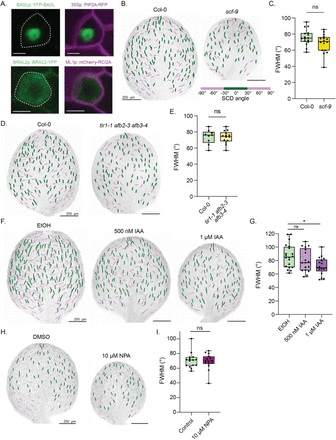
Evidence for Early Evolution of Sulfated Peptide Signaling in Plant Development
Devin V. Tulio, Alexandra M. Shigenaga, Shu-Zon Wu, Pamela C. Ronald, Magdalena Bezanilla
MicroRNA166-HD-ZIP III module impacts tuber shape, color and productivity in potato
Nikita Sunil Patil, Arati Vasav, Jyoti Kumari, Gourav Arora, Bhavani Natarajan, Anjan K. Banerjee
Parallel CLE peptide signaling pathways control nodulation in pea
Tiana E. Scott, Kate E. Wulf, Alejandro Correa-Lozano, Karen Velandia, James B. Reid, Eloise Foo
MpNPR modulates lineage-specific oil body development and defence against gastropod herbivory in Marchantia polymorpha
Loreto Espinosa-Cores, Santiago Michavila, Marina Gonzalez-Zuloaga, Roberto Solano, Selena Gimenez-Ibanez
Nuclear envelope dysfunction drives premature aging and modulates heterochromatic methylome drift in Arabidopsis
Oscar Juez, Hidetoshi Saze
Systemic and local regulation of root growth by vascular trehalose 6-phosphate is correlated with re-allocation of primary metabolites between shoots and roots
Moritz Göbel, Jacqueline Foster, Philipp Westhoff, Noemi Skorzinski, Hannah L Lepper, Maria F Njo, Markus Schmid, Tom Beeckman, Miloš Tanurdžić, Anna Amtmann, Franziska Fichtner
Key molecular and cellular events of table olive fruit abscission zone formation during natural maturation and after ethephon treatment
Minmin Wang, Emily Santos, Shaina Eagle, Alisa Chernikova, Shuxiao Zhang, Phuong Tran, Giulia Marino, Judy Jernstedt, Franz Niederholzer, Becky Wheeler-Dykes, Thomas Wilkop, Louise Ferguson, Georgia Drakakaki
The EGY1-SGR1 module controls chloroplast development and senescence by modulating photosynthetic functions
Alexey Shapiguzov, Andrea Trotta, Ilaria Mancini, Umama Hani, Nasrin Sultana, Triin Vahisalu, Cezary Waszczak, Eva-Mari Aro, Mikael Brosché
Antirrhinum flower shape: unravelling gene expression across developmental axes and boundaries
Ana Maria Cunha, João Raimundo, Alexandra Verweij, Desmond Bradley, Enrico Coen, Maria Manuela Ribeiro Costa
Fern and gymnosperm SPCH/MUTE and FAMA can regulate multiple cell fate transitions during stomatal development
Miki Zaizen-Iida, Kaotar Elhazzime, Anne Vatén
FLOWERING LOCUS T1 is a pleiotropic regulator of reproductive development, plant longevity, and source-sink relations in barley
Gesa Helmsorig, Tianyu Lan, Einar B. Haraldsson, Thea Rütjes, Philipp Westhoff, Katrin Weber, Jochen Kumlehn, Götz Hensel, Rüdiger Simon, Maria von Korff
Dynamic epigenetic and transcriptional regulatory network in pepper fruit development and ripening
Qian Liu, Javier Jingheng Tan, Rui Yang, Xiaoyi Li, Danhua Jiang
Nuclear auxin signalling induces autophagy for developmental reprogramming
Caterina Giannini, Christian Löfke, Geraldine Brunoud, Enric Bertran Garcia de Ollala, Bin Guan, Stefan Riegler, Anastasia Teplova, Andres Perez Gonzalez, Marintia M. Nava García, Eva Benkova, Teva Vernoux, Yasin Dagdas, Jiří Friml
Functional Characterization of Target of Rapamycin (TOR) Signalling in Physcomitrella
Elie Saliba, Sebastian N. W. Hoernstein, Nico van Gessel, Alexander Sentimenti, Karoline M. V. Höß, Juliana Parsons, Eva L. Decker, Pitter F. Huesgen, Henrik Toft Simonsen, Ralf Reski
The developing leaf of the wild grass Brachypodium distachyon at single-cell resolution
Lea S. Berg, Paola Ruiz Duarte, Inés Hidalgo Prados, Nathan T. Lacombe, Rashmi Tandon, Isaia Vardanega, Jan E. Maika, Roxane P. Spiegelhalder, Ambuj Gore, Heike Lindner, Rüdiger Simon, Michael T. Raissig
Methionine Triggers Metabolic, Transcriptional, and Epigenetic Reprogramming in Arabidopsis Leaves
Yonatan Yerushalmy, Michal Dafni, Nasrin Rabach, Yael Hacham, Rachel Amir
Delineating Mutation Bias and Selection during Plant Development
J Grey Monroe, Mariele Lensink, Vianney Ahn, Matthew W. Davis, Satoyo Oya, Kehan Zhao
| Environment, evolution and development
Dual origins for neural cells during development of the Clytia planula larva
Antonella Ruggiero, Anna Ferraioli, Sandra Chevalier, Pascal Lapébie, Romain Girard, Tsuyoshi Momose, Carine Barreau, Evelyn Houliston

Single-cell transcriptomics uncover conserved molecular mechanisms and functional diversification in multilayered epithelia
Candice Merle, Mathilde Huyghe, Erica Kimber, Marisa M. Faraldo, Sophie Pantalacci, Marie Semon, Silvia Fre, Robin P. Journot
Pre-cheliceral region patterning in a spider provides new insights into the development and evolution of arthropod neurosecretory centres
Amber Harper, Lauren Sumner-Rooney, Ralf Janssen, Alistair P. McGregor
Phylogenomics supports monophyly of marsupial crustaceans: a journey to direct development
Anna-Chiara Barta, Markus Grams, Heather Bracken-Grissom, Saskia Brix, Lívia M. Cordeiro, Brittany Cummings, Stormie Collins, William J. Farris, Sarah Gerken, Christoph G. Höpel, Anne-Nina Lörz, Siena McKim, Kenneth Meland, Luise Kruckenhauser, Jørgen Olesen, Pedro A. Peres, Stefan Richter, Regina Wetzer, Jason Williams, Kevin M. Kocot, Martin Schwentner
Genomic resources of Ascidiella aspersa and comparative analysis across tunicates reveal conserved class-level features and evolutionary diversification
Takumi T. Shito, Vasanthan Jayakumar, Koki Nishitsuji, Yoshie Nishitsuji, Shimon Kawai, Shunsuke O. Miyasaka, Kotaro Oka, Yasubumi Sakakibara, Kohji Hotta
When morphology stands still: constrained floral evolution in a mega-diverse legume genus
Monique Maianne, Yago Barros-Souza, Fabio A. Machado, Leonardo M. Borges
Environmental sex determination in the cyst nematode Globodera pallida defaults to male development
Arno S. Schaveling, Stefan J.S. van de Ruitenbeek, Geert Smant, Mark G. Sterken
doi.org/10.1101/2025.11.04.686318
Cell Biology
Developmental and transcriptional programs that define the initiation of the forelimb
Vighnesh Ghatpande, Alecxander J. Lewis, Kathryn E. Windsor, Hyunji Lee, Aaron J. Alcala, Douglas B. Menke, Can Cenik, Steven A. Vokes
Receptor stoichiometry predicts artery-typical vulnerability to altered Notch signaling during smooth muscle differentiation
Sami Sanlidag, Noora Virtanen, Hesam Hoursan, Tommaso Ristori, Marika Sjöqvist, Sandra Loerakker, Cecilia Sahlgren
An avidity-driven mechanism of extracellular BMP regulation by Twisted gastrulation
Gareth Moore, Raluca Revici, Lauren Forbes Beadle, Catherine Sutcliffe, Holly Birchenough, Clair Baldock, Hilary L Ashe
Differential functions of multiple Wnts and receptors in cell polarity regulation in C. elegans
Hitoshi Sawa, Masayo Asakawa, Takefumi Negishi
Axon-specific mRNA translation shapes dopaminergic circuit development
C. Gora, B. Frenette, P. Gelon, C. F. Sephton, S.M.I. Hussein, E. Metzakopian, M. Lévesque
An ancient transcription factor functions as the master regulator of primary cilia formation
Weihua Wang, Xiqi Zhang, Yaxuan Qiu, Xiangrui Meng, Sitong Cheng, Yutong Chen, Siqi liu, Wenhui Chen, Jiayan Yi, Xiwen You, Hongni Liu, Junqiao Xing, Cheng Xu, Haochen Jiang, Haibo Wang, Guangmei Tian, Zhangfeng Hu
Functional Characterization of Hsp110 in Drosophila Reveals its Essential and Dosage-Sensitive Role in Nervous System Integrity
Beatriz Rios, Shiyu Xu, Stephen M Farmer, Xin Ye, Lili Ye, Kevin A. Morano, Sheng Zhang
TEAD4 regulates apical domain homeostasis and cell-positioning to maintain the trophectoderm lineage during preimplantation mouse embryo development
Rebecca Collier, Martina Bohuslavová (née Stiborová), Michaela Vaškovičová, Aleksandar I. Mihaljović, Andrea Hauserová, Valeriya Zabelina, Monika Fluks, Lenka Gahurová, Dávid Drutovič, Alexander W. Bruce
The Drosophila ovary produces three follicle waves similar to those in mice
Wayne Yunpeng Fu, Allan C Spradling
LEM-3/ANKLE1 nuclease prevents the formation of syncytium between postmitotic sister cells and safeguards neuronal differentiation
Siyu Deng, Chaogu Zheng
The Dishevelled C-terminus interacts with the centrosomal protein Kizuna to regulate microtubule organization during ciliogenesis
Maya Lines, Kenan Murray, Anthea Luo, Taewoo Yang, Yoo-Seok Hwang, Christopher J Westlake, Ira O. Daar, Jaeho Yoon
Carbohydrate adaptation drives liver-brain axis maturation
Hongmei Cui, Zheng Wu, Yuannyu Zhang, Hieu S. Vu, Hongli Chen, Xiaofei Gao, Yan Jin, Donghong Cai, Sarada Achyutuni, Phong Nguyen, Chunxiao Pan, Hui Cao, Camenzind G. Robinson, Jeffrey D. Steinberg, Laura J. Janke, Sara M. Nowinski, Jian Xu, Ralph J. DeBerardinis, Min Ni
Modelling
Cell Trajectory Inference based on Schrödinger Problem and a Mechanistic Model of Stochastic Gene Expression
Clémence Fournié, Elias Ventre, Ulysse Herbach, Aymeric Baradat, Olivier Gandrillon, Fabien Crauste
The emerging role of receptor trafficking in signalosome formation and sustained long-term Wnt/β-catenin signaling
Fiete Haack, Kevin Burrage, Adelinde Uhrmacher
Self-Organization Through Local Cell-Cell Communication Drives Intestinal Epithelial Zonation
Yael Heyman, Michal Erez, Phil Burnham, Mor Nitzan, Arjun Raj
Redefining Housekeeping Genes in the Context of Vertebrate Development
Alicia Lou, Juan F Poyatos, Monica Chagoyen
Computational Cellular Programming: In Silico Modeling of Direct and Reprogrammed Hepatic Lineage Induction via Gene Regulatory and Functional Dynamics
Sa Dharmasastha Karthikeya, Prathiba Jonnala
Androgen receptor activation stabilizes a hybrid epithelial/mesenchymal phenotype in presence of Notch-Jagged signaling
Souvik Guha, R Soundharya, Baishakhi Tikader, Mohit Kumar Jolly
A Deep Learning Framework for Quantifying Dynamic Self-Organization in Myxococcus xanthus
Jiangguo Zhang, Eduardo A. Caro, Peiying Chen, Trosporsha Tasnim Khan, Patrick A. Murphy, Lawrence J. Shimkets, Ankit B. Patel, Roy D. Welch, Oleg A. Igoshin
Coupling mathematical modeling with a novel human intestinal stem cell system to understand feedback regulation during planar cell polarity
Keith A. Breau, Emma G. Dunahey, Henry V. Fosnocht, Scott T. Magness, Timothy C Elston
Integration of Hematopoietic and Thymus-like Niches in a Human iPSC-derived Bone Marrow Organoid
Jiyoung Lee, Tomoyuki Kawasaki, Lilika Tabata, Junlong Chen, Toru Uchiyama, Satoshi Yamazaki, Akihiro Umezawa, Hidenori Akutsu
Tools & Resources
Customizable FDM-based zebrafish embryo mold for live imaging
Marcela Xiomara Rivera Pineda, Jaakko Lehtimäki, Guillaume Jacquemet
Goldilocks conundrum explains cryoinjury in slow-cooled amphibian embryonic cells
Roshan Patel, Rose Upton, Simon Clulow, Brett Nixon, Michael Mahony, John Clulow
Morphometric analyses of shape: The analysis software toolbox for quantification of craniofacial shape
Makenzie C. Stearsman, Jennan A. Lahamer, Raèden Gray, C. Ben Lovely
In Ovo Sexing and Genotyping using PCR techniques: A Contribution to the 3R Principles in Chicken Breeding
Dierks, A. Förster, D. Meunier, R. Preisinger, C. Klein, S. Weigend, S. Altgilbers
Acridine Orange dye for long-term staining and live imaging of cnidarian development and regeneration
Vaidehi Patel, Valeria Dountcheva, Labib Rouhana
Simple Methods to Acutely Measure Multiple Timing Metrics among Sexual Repertoire of Male Drosophila
Yutong Song, Dongyu Sun, Xiao Liu, Fan Jiang, Xuejiao Yang, Woo Jae Kim
Behavioral age-detection in individuals reconstructs minute-scale developmental transcriptomics
Nabeel S. Ganem, David Scher-Arazi, Sharon Inberg, Amit Zeisel, Shay Stern
Research practice & education
The Research Mind: A Multi-Dimensional Framework for Evaluating Research Quality, Productivity, and Integrity by Mitigating citation bias
Sanjay Rathee, Chanchal Chaudhary
Researchers‘ perspectives on preregistration in animal research
Cristina Priboi, Boris Mayer, Evie Vergauwe, Bernice Elger, Hanno Würbel


 (1 votes)
(1 votes) (No Ratings Yet)
(No Ratings Yet)